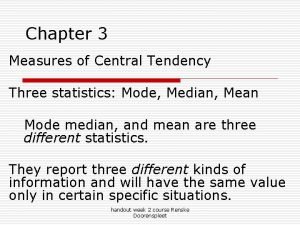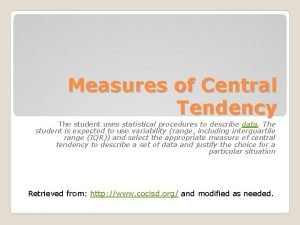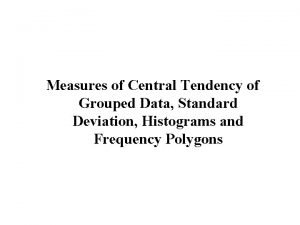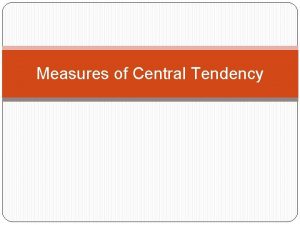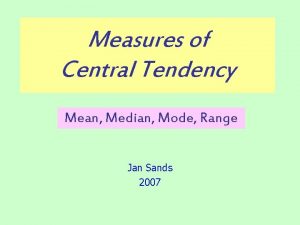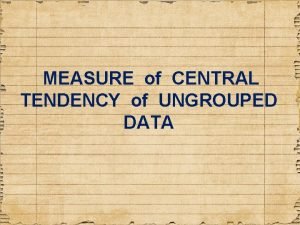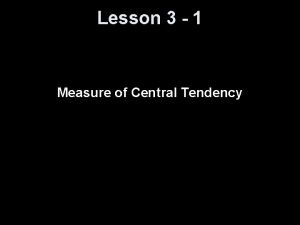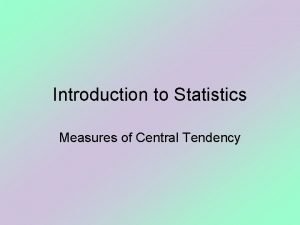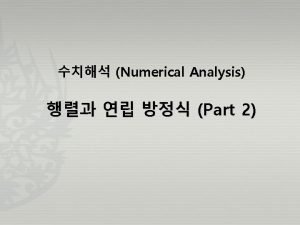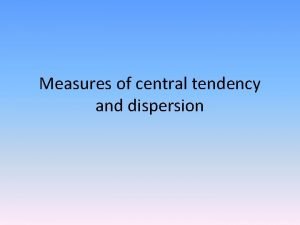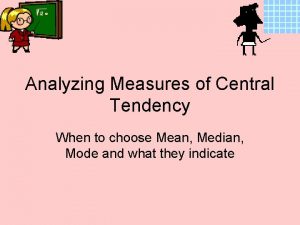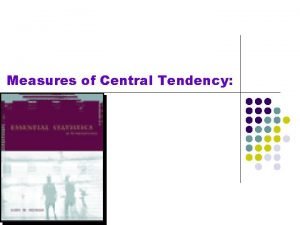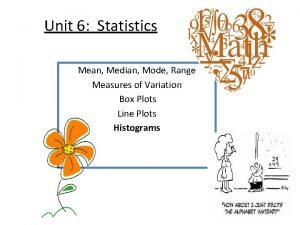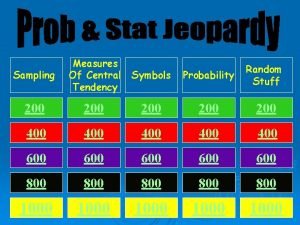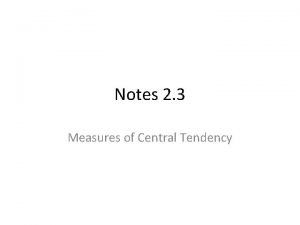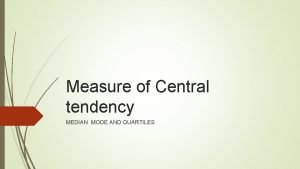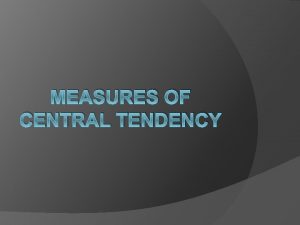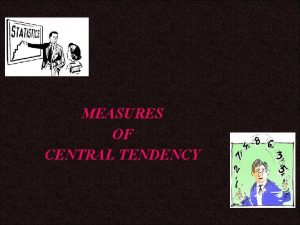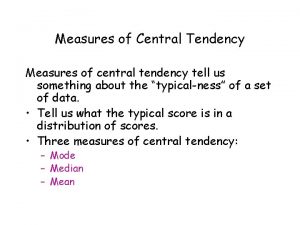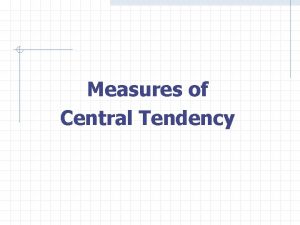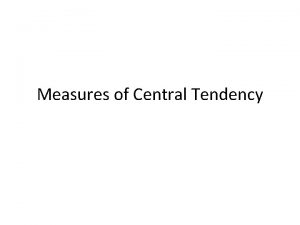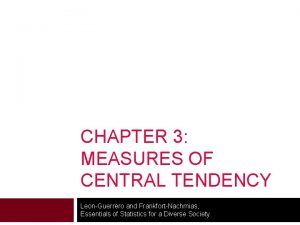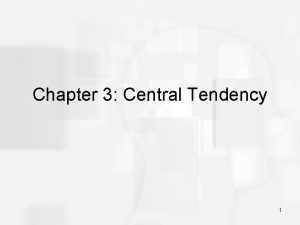CHAPTER 3 MEASURES OF CENTRAL TENDENCY LeonGuerrero and



















- Slides: 19

CHAPTER 3: MEASURES OF CENTRAL TENDENCY Leon-Guerrero and Frankfort-Nachmias, Essentials of Statistics for a Diverse Society

Chapter 3: Measures of Central Tendency The Mode The Median The Mean Finding the Mean in a Frequency Distribution The Shape of the Distribution Considerations for Choosing a Measure of Central Tendency Statistics in Practice: Representing Income Leon-Guerrero/Frankfort-Nachmias: Essentials of Social Statistics for a Diverse Society © 2012 SAGE Publications

What is a measure of Central Tendency? • Numbers that describe what is average or typical of the distribution • You can think of this value as where the middle of a distribution lies. Leon-Guerrero/Frankfort-Nachmias: Essentials of Social Statistics for a Diverse Society © 2012 SAGE Publications

The Mode • The category or score with the largest frequency (or percentage) in the distribution. • The mode can be calculated for variables with levels of measurement that are: nominal, ordinal, or interval-ratio. Leon-Guerrero/Frankfort-Nachmias: Essentials of Social Statistics for a Diverse Society © 2012 SAGE Publications

The Mode: An Example: Number of Votes for Candidates for Mayor of Camarillo, California. The mode, in this case, gives you the “central” response of the voters: the most popular candidate. Sheriff Tupper – 11, 769 votes Jessica Fletcher – 39, 443 votes Hazlett” The Mode: “Dr. Seth Hazlett – 78, 331 votes Leon-Guerrero/Frankfort-Nachmias: Essentials of Social Statistics for a Diverse Society © 2012 SAGE Publications

The Median The score that divides the distribution into two equal parts, so that half the cases are above it and half below it. The median is the middle score, or average of middle scores in a distribution. Leon-Guerrero/Frankfort-Nachmias: Essentials of Social Statistics for a Diverse Society © 2012 SAGE Publications

Median Exercise #1 (N is odd) Calculate the median for this hypothetical distribution: Job Satisfaction Frequency Very High Moderate Low Very Low 2 3 5 TOTAL 21 7 4 Leon-Guerrero/Frankfort-Nachmias: Essentials of Social Statistics for a Diverse Society © 2012 SAGE Publications

Median Exercise #2 (N is even) Calculate the median for this hypothetical distribution: Satisfaction with Health Very High Moderate Low Very Low TOTAL Frequency 5 7 6 7 3 28 Leon-Guerrero/Frankfort-Nachmias: Essentials of Social Statistics for a Diverse Society © 2012 SAGE Publications

Percentiles A score below which a specific percentage of the distribution falls. � For example, the 75 th percentile is a score that divides the distribution so that 75% of the cases are below it. � For example, the 25 th percentile is a score that divides the distribution so that 25% of the cases are below it. Leon-Guerrero/Frankfort-Nachmias: Essentials of Social Statistics for a Diverse Society © 2012 SAGE Publications

The Mean The arithmetic average obtained by adding up all the scores and dividing by the total number of scores. Leon-Guerrero/Frankfort-Nachmias: Essentials of Social Statistics for a Diverse Society © 2012 SAGE Publications

Formula for the Mean Where ΣY = sum of all scores N = the number of scores. Leon-Guerrero/Frankfort-Nachmias: Essentials of Social Statistics for a Diverse Society © 2012 SAGE Publications

Calculating the mean with grouped scores where: f Y = a score multiplied by its frequency Leon-Guerrero/Frankfort-Nachmias: Essentials of Social Statistics for a Diverse Society © 2012 SAGE Publications

Example: Mean of Grouped Scores Leon-Guerrero/Frankfort-Nachmias: Essentials of Social Statistics for a Diverse Society © 2012 SAGE Publications

Mean: Grouped Scores Leon-Guerrero/Frankfort-Nachmias: Essentials of Social Statistics for a Diverse Society © 2012 SAGE Publications

Grouped Data: the Mean & Median Calculate the median and mean for the grouped frequency below. Number of People Age 18 or older living in a U. S. Household in 1996 (GSS 1996) Number of People Frequency 1 2 3 4 5 6 190 316 54 17 2 2 TOTAL 581 Leon-Guerrero/Frankfort-Nachmias: Essentials of Social Statistics for a Diverse Society © 2012 SAGE Publications

Shape of the Distribution Symmetrical (mean is about equal to median) Skewed � Negatively (example: years of education) mean < median � Positively (example: income) mean > median Bimodal (two distinct modes) Multi-modal (more than 2 distinct modes) Leon-Guerrero/Frankfort-Nachmias: Essentials of Social Statistics for a Diverse Society © 2012 SAGE Publications

Distribution Shape Leon-Guerrero/Frankfort-Nachmias: Essentials of Social Statistics for a Diverse Society © 2012 SAGE Publications

Considerations for Choosing a Measure of Central Tendency For a nominal variable, the mode is the only measure that can be used. For ordinal variables: -Use the mode to show what is the most common value in the distribution. -Use the median to show which value is located exactly in the middle of the distribution. For interval-ratio variables, the mode, median, and mean may all be calculated. The mean provides the most information about the distribution, but the median is preferred if the distribution skewed. Leon-Guerrero/Frankfort-Nachmias: Essentials of Social Statistics foris a Diverse Society © 2012 SAGE Publications

Central Tendency Leon-Guerrero/Frankfort-Nachmias: Essentials of Social Statistics for a Diverse Society © 2012 SAGE Publications
 Statistics chapter 3 measures of central tendency
Statistics chapter 3 measures of central tendency Purpose of measures of central tendency
Purpose of measures of central tendency Measures of central tendency and variation
Measures of central tendency and variation Measures of central tendency
Measures of central tendency Ungrouped data
Ungrouped data Objective of central tendency
Objective of central tendency Measures of central tendency range
Measures of central tendency range Central tendency symbols
Central tendency symbols Objectives of measures of central tendency
Objectives of measures of central tendency Measures of central tendency
Measures of central tendency Mean mode median formula
Mean mode median formula Nxn 역행렬 알고리즘
Nxn 역행렬 알고리즘 Measure of central tendency and dispersion
Measure of central tendency and dispersion Choosing the best measure of central tendency worksheets
Choosing the best measure of central tendency worksheets Central tendency
Central tendency Measure of central tendency of grouped data
Measure of central tendency of grouped data Mode in statistics
Mode in statistics Measures of central tendency symbols
Measures of central tendency symbols Measures of central tendency notes
Measures of central tendency notes In quartiles central tendency median is
In quartiles central tendency median is
